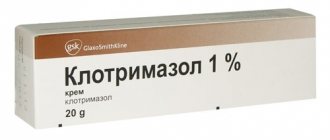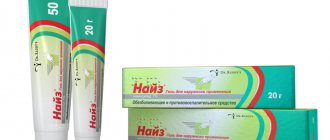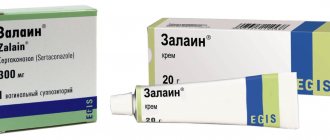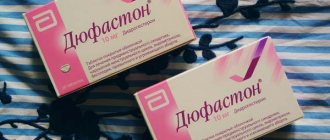Compound
Gel 1% contains clotrimazole at a concentration of 10 mg/g, propylene glycol, macrogol 400, carbomer , rectified ethyl alcohol 96% from food raw materials, glycerol , sage ethereal extract.
Cream composition 1%: clotrimazole at a concentration of 10 mg/g, cetostearyl and benzyl alcohols, polysorbate 60, synthetic spermaceti, octyldodecanol, sorbitan stearate, water.
Composition of the ointment 1%: clotrimazole at a concentration of 10 mg/g, polyethylene oxides 400 and 1500, propylene glycol, methylparaben, nipagin.
Composition of the 1% solution: clotrimazole at a concentration of 10 mg/ml (in terms of dry matter), polyethylene glycol 400, propylene glycol, ethanol 96%.
Composition of suppositories: one suppository contains 100 mg of active substance and base in the volume necessary to obtain a suppository weighing 2 g. Clotrimazole suppositories contain semi-synthetic glycerides as a base.
Composition of tablets: 100, 200 or 500 mg of clotrimazole, lactose in the form of monohydrate, potato starch, adipic acid, sodium bicarbonate, silicon dioxide in colloidal form, sodium lauryl sulfate.
https://youtu.be/J1zzwXTyxCQ
Clotrimazole for fungus
According to the pharmacological classification, Clotrimazole is part of a group of drugs with an antifungal effect and a wide spectrum of action. With its help, you can eliminate the signs of multi-colored lichen, fungal manifestations on the skin and mucous membranes of the genital tract. A product with an antimycotic effect is used topically, externally or intravaginally, and has several different release forms. It is allowed to be used by children and adults.
| Clotrimazole concentration | Auxiliary components | Description | Package | |
| Cream | 1 g per 100 g | Cetostearyl and benzyl alcohol, sorbitan stearate, octyldodecanol, polysorbate, water, synthetic spermaceti | White, uniform | Aluminum tube 20 g |
| Ointment | Monoglycerides, cetostearyl alcohol, castor oil, emulsion wax, polysorbate, glycerol, methyl and propyl parahydroxybenzoate, propylene glycol, water | White-yellowish with a faint odor | 15 and 30 g aluminum tubes | |
| Gel | 10 mg per 1 g | Ethyl alcohol, glycerol, macrogol, carbomer, sage extract, propylene glycol | Homogeneous transparent gel with sage scent | 20 and 40 g aluminum tubes |
| Solution | 10 mg per 1 ml | Ethanol, propylene glycol, polyethylene glycol | Transparent colorless liquid | 25 ml, glass bottles with applicators |
| Vaginal suppositories | 100 mg per 1 piece. | Semi-synthetic glycerides | Cylindroconical shape, white-yellow color, cut with an air core or funnel-shaped depression | 6 pcs. in blister packs |
| Vaginal tablets | Magnesium stearate, adipic acid, lactose monohydrate, sodium bicarbonate, potato starch, sodium lauryl sulfate, colloidal silicon dioxide | White oblong | 6 pcs. in blisters |
The main substance inhibits the growth and reproduction of microorganisms, has a fungistatic effect and fungicidal activity, and leads to the death of fungi. Due to inhibition of ergosterol synthesis, the component combines with phospholipids of the fungal cell membrane, changing its permeability. In high concentrations, clotrimazole damages fungal cells by lysis without suppressing the synthesis of ergosterol, prevents the formation of proteins, fats and polysaccharides of fungi, destroys their nucleic acids and increases the excretion of potassium.
The drug has a broad effect on dermatophytes, yeasts, dimorphic and mold fungi, protozoa, plus it destroys gram-positive bacteria. Fungistatic activity is manifested against the mycelium of dermatophytes, budding fungi from the genus Candida. The component is practically not absorbed into the systemic bloodstream when applied to intact and non-inflamed skin.
For external use of ointment, gel, cream and solution, according to the instructions, the following indications are distinguished:
- fungal diseases caused by dermatophytes, yeast-like fungi, mold pathogens sensitive to the active component;
- mycoses of the feet and hands;
- candidiasis vulvitis, balanitis with localization of the fungus inside the body;
- lichen versicolor, erythrasma;
- mycosis of the skin;
- fungal infection of the outer ear.
When using intravaginal forms of the drug (solution, suppositories and tablets), the indications are:
- infections of the genital organs caused by yeast-like fungi of the genus Candida;
- vulvovaginal candidiasis;
- urogenital infections;
- trichomoniasis;
- genital superinfections caused by microorganisms that are sensitive to the active ingredient of the drug;
- sanitation of the birth canal before childbirth.
Release form
- gel 1% (pack of 20 and 40 g);
- cream 1% (tubes 15, 20, 30 and 50 g);
- ointment 1% (tubes 15, 20, 30 and 40 g);
- 1% solution (15 ml bottles);
- vaginal suppositories 0.1 g (package No. 6);
- vaginal tablets 0.1, 0.2 or 0.5 g (packaging No. 1, No. 3, No. 6; tablets are equipped with an applicator).
Clotrimazole tablets and vaginal suppositories have an ATC code different from other dosage forms of the drug - G01AF02.
Clotrimazole can also be produced in the form of granules, powder for external use, or spray.
The drug is intended for local (including intravaginal) and external use; tablets for oral administration are not available.
In childhood
To treat fungal diseases in children, you can use Clotrimazole cream, ointment and solution. The dosage is according to the instructions, no different from adults. Vaginal tablets are allowed to be used from 12 years of age. Indications for use:
- Treatment of oral candidiasis. 10-20 drops of the solution are applied to a cotton swab and wiped over the affected areas 3-4 times a day, the course lasts until the symptoms disappear completely (about 2-3 days).
- Fungal infections of the skin, mucous membranes, nail fungus. Use cream or ointment 1-3 times/day.
Pharmacodynamics and pharmacokinetics
Clotrimazole is an imidazole .
In vitro, exhibits high activity against the most pathogenic fungi , which can cause serious infectious complications, namely:
- dermatophytes (Microsporum sp., Epidermophyton floccosum, Trichophyton sp.);
- yeast-like fungi (Cryptococcus neoformans, Candida sp.);
- dimorphic fungi (Histoplasma capsulatum, Paracoccidicides brasiliensis, Coccidiodes immitis).
The mechanism of action of clotrimazole is based on its ability to block the synthesis of proteins, nucleic acids and ergosterol, which is necessary for the construction of cell membranes of fungi. As a result, the cell membranes of the fungi are damaged and the cells die.
At low concentrations, clotrimazole has a fungistatic effect. If the dose exceeds 20 mcg/ml, the drug has a fungicidal effect, and not only on proliferating cells.
When used in high doses, it helps to increase the concentration of hydrogen peroxide in the fungal cell to a toxic value and, as a result, destroys the fungal cells
When applied topically, the drug is absorbed by the epidermis . The highest concentration of the substance is determined in the reticuloderm . It is also able to penetrate the keratin of nails.
Clotrimazole enters the systemic circulation in very small quantities. Metabolized in the liver to inactive substances that are excreted from the body in feces and urine.
When administered intravaginally, 5 to 10% of clotrimazole is absorbed. The absorbed substance is metabolized in the liver. Metabolic products are excreted in bile.
Pharmacological properties of Clotrimazole
Clotrimazole is an antimycotic agent representing a group of imidazole derivatives for intravaginal or topical use.
It has a therapeutic effect by disrupting the formation of fungal sterols, which underlie their cell membranes. It has a wide spectrum of action against both a large number of fungi and other microorganisms. Imidazole derivatives penetrate tissue well. Most of them are found in the outer layer of the skin, less in the hypodermis and lower layers of connective tissue. Clotrimazole does not have systemic effects. Once in the body, it affects the membranes of fungi, depriving them of viability.
This remedy is most effective in the fight against vulvovaginal candidiasis. Sometimes it is combined with oral medications to achieve maximum therapeutic effect. The patient experienced noticeable improvements from the first days of treatment.
“If a woman feels a noticeable improvement after just 2-3 tablets of Clotrimazole, then she should not stop the course of treatment. If you do not listen to the doctor’s recommendations and arrogantly interrupt the course, then the disease can become chronic.”
Indications for use: what is Clotrimazole ointment, cream, gel, suppositories and tablets for?
What do Clotrimazole ointment, gel, cream and solution help with?
The drug is prescribed for the treatment of fungal infections of the skin , which are caused by molds and yeasts , dermatophytes and other pathogens sensitive to clotrimazole.
They are also used as remedies for lichen caused by Malassezia furfur and erythrasma (caused by Corynebacterium minutissimum).
Clotrimazole ointment, cream, gel and solution help: against nail fungus ( onychomycosis , fungal paronychia ), trichophytosis , dermatophytosis , fungal erosion and diaper rash, candidiasis , microsporia , athlete's foot , dermatomycosis , complicated by secondary pyoderma mycoses .
Indications for the use of ointment, gel, cream and solution include infectious diseases, pathogens that are resistant to nystatin and a number of other antifungal agents.
for the treatment of pityriasis rosea , since this disease is most likely of viral or infectious-allergic origin , and may also be the body’s response to a severe shock or nervous breakdown. Clotrimazole is effective against fungal infections .
The use of Clotrimazole ointment, gel and cream with Clotrimazole in gynecology is indicated:
- for the treatment and prevention of thrush ;
- for the prevention of repeated fungal infections of the female reproductive system , which develop during long-term treatment with antibiotics or against the background of immunodeficiency conditions.
Also, solution, gel, cream and ointment in gynecology are used to sanitize the genital tract before delivery.
Candles - what are they for?
The indication for the use of vaginal suppositories is vaginal candidiasis and genital superinfections caused by microorganisms sensitive to clotrimazole. The drug is prescribed to women and, after the onset of sexual activity, to teenage girls.
What are Clotrimazole tablets for?
Clotrimazole tablets are used to treat blastomycotic infections of the vulva and vagina . In particular, the drug is prescribed for vaginitis caused by fungi of the genus Candida (including diseases caused by strains resistant to nystatin ), caused by other pathogens sensitive to clotrimazole, superinfections of the genital organs , for sanitization of the genital tract before delivery.
Features of application
If a woman is pregnant, she should use any medications very carefully. Therapy with Clotrimazole can begin in the second trimester, since this drug is contraindicated in the first trimester.
Before starting to use vaginal suppositories, the expectant mother must consult with her gynecologist.
If the doctor gives a prescription, she can begin therapy. It is worth noting that throughout the entire medication course the patient will be under the supervision of specialists.
Side effects
Allergic reactions.
When applied to the skin, the following side effects are possible:
- burning;
- edema;
- the appearance of blisters;
- erythema;
- skin irritation;
- tingling sensation
- peeling.
Local use for urogenital mycoses may be accompanied by burning, itching, swelling and hyperemia of the mucous membrane, intercurrent cystitis , the appearance of vaginal discharge, increased urination, pain during sexual intercourse.
When applied topically for mycoses of the oral cavity, redness of the mucous membrane, tingling and burning sensation at the site of application of the drug, and irritation may be observed.
Rules for using Clotrimazole suppositories for the treatment of thrush
- Store candles at room temperature. Clotrimazole suppositories, produced by various manufacturers, usually consist of the active substance, fats and water-soluble polymers. After insertion into the vagina, they begin to melt. To prevent the suppositories from melting, the drug should be stored at room temperature before administration. If you live in a hot climate where the indoor temperature is above 25°C, place the candles in the refrigerator.
- Use suppositories even during menstruation. If you experience menstruation during treatment for thrush, you should not interrupt the course of therapy; you should continue administering the suppositories as prescribed by the doctor. Just use a sanitary pad, not tampons. It should be noted that during menstruation, the effectiveness of Clotrimazole suppositories is still reduced, so it is better to carry out treatment outside of this period.
- Insert suppositories into the vagina at night. Since suppositories after insertion may leak from the vagina in an upright position, it is better to use them at night, before bed. Do not use tampons to stop the melted suppository from flowing out, as they absorb the active substance, which can significantly reduce the effectiveness of the drug. Tampons can also irritate the vaginal lining.
- Monitor for side effects. Most of the side effects of Clotrimazole suppositories are local in nature and do not require medical attention. Most often, discomfort, burning or itching develops in the vagina. Allergic reactions are also possible, manifested by swelling of the vagina and perineal area, rash and a feeling of stiffness in the chest.
- If you forget to administer the suppository, after remembering, continue the course of treatment. If you have not administered the suppositories for two days in a row, their effectiveness will be reduced and the infection may not be completely eliminated. In this case, you need to consult a doctor.
- Know when to seek medical help. Consult your doctor if you experience side effects or if you do not know how to insert suppositories into the vagina correctly. Also ask him if you need to abstain from sex during treatment.
- Clotrimazole may damage the latex in condoms and diaphragms, so do not rely on these methods of contraception. Therefore, use other methods for at least five days after using these suppositories. Also remember that vaginal sex during thrush can infect your partner, so it is still better to abstain from it until you have completely recovered.
- If your partner also has symptoms of thrush (in men this disease manifests itself as pain and redness on the penis, white discharge from under the foreskin or from the urethra), he should be treated at the same time as you. For this you can use, for example, Clotrimazole ointment.
- During pregnancy, before using Clotrimazole suppositories, their potential benefits and possible harms should be assessed. It is best not to use this drug in the 1st trimester. If you are breastfeeding a child, breastfeeding should be suspended during treatment.
- When a fungal infection of the vagina and vulva is combined, you should additionally use an ointment containing clotrimazole, which should be applied only to the affected areas of the skin.
Clotrimazole ointment
Successful treatment with Clotrimazole in the form of vaginal suppositories is possible only if the patient has uncomplicated symptoms of vaginal candidiasis. The classic version of the pathology develops under the influence of short-term unfavorable conditions. It can be a consequence of treatment with antibacterial drugs or against the background of hormonal changes in the body.
The following characteristic symptoms can be identified:
- Abundant cheesy discharge with a sour smell is the very first sign. If a secondary bacterial infection occurs, the discharge may acquire a yellowish or greenish tint, as well as streaks of blood.
- Itching and burning in the area of the external genitalia and perineum. If the patient takes a shower and dries out the mucous membrane, the itching becomes less pronounced.
- The genitals, as well as the vaginal mucosa, become hyperemic and slightly swollen. When touching the external genitalia, a woman experiences discomfort and pain.
If a woman encounters the listed symptoms for the first time, and embarrassment or too much busyness prevents her from going to the hospital, then she can try the intravaginal use of Clotrimazole. But in this case, there is a risk of choosing the wrong treatment and becoming the owner of chronic thrush.
Thrush does not pose a serious threat to a woman's life. This is more due to constant discomfort, a feeling of fatigue, weakness and the inability to enjoy intimacy. But on the other hand, vaginal candidiasis must be considered as a marker of the presence of other diseases and treated in a timely manner, as well as undergo a comprehensive examination.
Instructions for use of Clotrimazole: Clotrimazole for women and men
Clotrimazole ointment: instructions for use. How to apply Clotrimazole ointment for men?
Before applying Clotrimazole ointment (Acri or other manufacturers), the affected areas of the body are first washed with soapy water and dried thoroughly.
The drug is applied to the affected areas (covering small areas of healthy skin around the lesion) in a thin layer from 1 to 3 r./day. and rub lightly.
For 1 treatment of an area the size of a palm, a 5-mm strip of ointment is sufficient.
Regardless of what pathogen causes the disease, treatment after relief of subjective symptoms is recommended to continue for another 2 weeks.
For dermatomycosis, the course of treatment lasts from 3 to 4, for erythrasma - from 2 to 4, for lichen versicolor - from 1 to 3 weeks.
If there is no clinical improvement after 4 weeks of regular use of the drug, the patient is sent for a repeat microbiological study and the treatment regimen is revised.
The use of ointment for thrush in women helps block the spread of fungal cells and, when higher doses are prescribed, ensures their complete destruction. For therapeutic purposes, Clotrimazole for thrush is used 2 times a day, rubbing the ointment into the affected areas of the perineum.
Until the drug is absorbed, it is recommended not to wear underwear.
For men, the method of use for thrush and other fungal infections of the genital organs ( candidal balanoposthitis , urogenital candidiasis ) is the same as for women.
The ointment is applied to the foreskin and glans penis and gently rubbed into the skin and mucous membrane. Frequency of applications - 2 times/day.
The drug is poorly absorbed into the skin, and its active substance is characterized by the ability to gradually accumulate in the upper layer of the skin. Thanks to these properties, Clotrimazole ointment is highly effective for thrush in men and women.
Clotrimazole cream: instructions for use
The cream is intended for topical use. For thrush and other fungal diseases , apply it to the affected areas twice or thrice during the day and rub in lightly.
If mycoparasites affect the genitals, to treat thrush , the cream is prescribed simultaneously to both partners. For candidal balanitis or balanoposthitis, clotrimazole cream for men is used in the same way as ointment.
The duration of the course depends on the indications for use and ranges from 1-2 (for candidal balanitis/vulvitis ) to 3-4 weeks (for dermatomycosis ).
To prevent relapse of the disease, it is very important not to stop treatment for another 2 weeks after the subjective symptoms of infection disappear. If there is no improvement after 4 weeks of therapy, the patient should consult a doctor.
Vaginal cream Clotrimazole is administered into the vagina in portions of 5 grams 1 time per day. within 3 days.
Instructions for the solution
Before applying Clotrimazole, the skin should be washed with warm soapy water (especially the areas between the fingers) and dried well. The affected areas are treated 2-3 times a day. The amount of solution should be sufficient for uniform application to the entire affected surface.
If the skin of the feet is affected, liquid Clotrimazole solution must be applied after each wash.
The solution is the most preferred dosage form for onychomycosis . This is due to the fact that it has the best penetrating properties.
For fungal infections of the oral cavity, the affected areas of the mucous membrane are treated with a cotton swab or swab, onto which drops are first applied (10 to 20 drops are enough to treat each ear). Frequency of procedures - 3-4 rubles/day.
After applying Clotrimazole, you should refrain from eating and drinking for an hour.
Clotrimazole drops are also effective against onomycosis caused by yeast fungi. Drops are administered into the ear using turundas: a twisted cotton ball is moistened in the solution and 3-4 times a day. Place it in the ear canal for 5-10 minutes. Treatment lasts from 3 to 4 weeks.
Instructions for the gel
The method of using the gel is similar to the method of using the ointment. The product is applied to the epidermis affected by mycoparasites 2-3 times a day. and rub in with light movements.
The peculiarity of this dosage form is that the gel is well distributed on the skin and is also well absorbed into it. This allows the drug to be used for treating hard-to-reach areas of the body.
The gel is used intravaginally in the same way as clotrimazole cream: 1 r./day. 5 grams each. The course of treatment is 3 days.
Clotrimazole vaginal tablets: instructions for use
In the absence of other prescriptions, Clotrimazole Acri tablets and synonymous drugs for thrush and other fungal infections of the genital organs are used:
- for 3 days, 1 tablet 2 times a day;
- for 6 days, 1 tablet 1 time per day.
How to administer Clotrimazole vaginal tablets? Before administration, the tablet is removed from the package and moistened with chilled boiled water. The drug should be administered in the “lying on your back” position with your knees bent.
In order for the tablet to completely dissolve and clotrimazole to work, a moist environment is necessary (otherwise, undissolved particles may spill out). Therefore, the tablet is inserted into the vagina as deeply as possible. It is optimal to carry out the procedure before bedtime.
Treatment must be stopped before menstruation begins. Menstrual flow will wash away the drug and it will not have the desired effect. During treatment with vaginal tablets, you should not use tampons, spermicides, intravaginal douching or any other vaginal products.
To sanitize the genital tract before delivery, a woman is given a single dose of 200 mg of clotrimazole.
During pregnancy , the drug is contraindicated in the 1st trimester. At later stages, clotrimazole does not have an adverse effect on the development of the fetus, however, the use of the applicator may be associated with certain risks.
Instructions for candles
Suppositories for thrush are used intravaginally. The drug should be injected deep into the vagina, one dose daily for 6 days. A repeat course is possible after consulting a doctor.
Clotrimazole suppositories for thrush and other urogenital mycoses are not used during menstrual bleeding. Treatment must be completed before it begins.
During pregnancy, the drug in this dosage form is used from the 2nd trimester and in situations where the expected benefit to the mother outweighs the possible risks to the fetus.
Reviews allow us to conclude that the drug quickly destroys fungal colonies and eliminates the unpleasant symptoms of mycoses. Its other advantages include low price and a large selection of dosage forms.
Clotrimazole analogues. Use of the drug, dosage
“Clotrimazole” (cream), analogs are used on disease-affected areas that have previously been cleaned and dried. The product is applied thinly to the skin, then gently rubbed. The procedure should be performed two or three times a day. To cleanse the skin, it is recommended to use soap with a neutral pH. The duration of therapy is determined by the severity of the condition, the location of the lesion, and the effectiveness of treatment.
Usually, it takes at least a month to eliminate ringworm; pityriasis versicolor can be eliminated in 1-3 weeks. Fungal infections of the feet are treated even after the symptoms that accompanied the disease disappear; in addition, it is necessary to lubricate the skin with the product for at least another half month.
“Clotrimazole” tablets and their analogues are used for six days. In the evening of each day, one tablet of the product is placed deep into the vagina. If there is such a need, another one is administered in the morning. The treatment period can be increased to twelve days. The most effective option is the simultaneous use of ointment and tablets. It is possible to repeat the course of treatment after it has been prescribed by a doctor. For easier administration of the tablet, you should lie on your back or bend your knees slightly.
Candidal balanitis and vulvitis are treated with cream, applying it to the affected areas two or three times daily. The duration of the course is at least six days, usually no more than twelve.
“Clotrimazole” suppositories and their analogues are prescribed to both women and girls. Their use is possible after the start of sexual activity. Suppositories are placed deep into the vagina in the evening. For easy insertion, you can lie on your back or bend your legs. You need to be treated for six days. Therapy can be continued only after receiving appropriate doctor's recommendations.
Preparations in the form of gel, ointment, cream are applied in a small layer and rubbed in gently. The procedure is repeated several times a day (2 or 3). The skin should be cleansed with a neutral pH product and dried.
Like other forms of medicine, the solution is also applied in a thin layer in the morning and evening and rubbed in well. It is necessary to use a few drops of the medicine. The solution is suitable for the treatment of adult patients and children. It is necessary to treat both the affected area and the areas adjacent to it. After the acute symptoms have disappeared, treatment is continued for about another month.
If the feet are affected by dermatomycosis, the medicine is used for another half a month after the symptoms are eliminated. The solution should be used after each foot washing procedure.
Overdose
When applied to the skin and intravaginally, there is no risk of acute intoxication, since clotrimazole enters the systemic circulation in very small quantities.
In case of accidental ingestion of Clotrimazole, nausea, anorexia, vomiting, gastralgia, and liver dysfunction are possible. In rare cases, pollakiuria, hallucinations, drowsiness, and allergic skin reactions are observed.
In this case, the patient is prescribed enterosorbents and symptomatic treatment. Gastric lavage is performed in situations where a life-threatening dose was taken within the previous hour, as well as in the presence of visible symptoms of an overdose (nausea, dizziness, vomiting).
Reviews
Leave your feedback in the comments!
* — Average value among several sellers at the time of monitoring, is not a public offer
Attention! The information presented in the article is for informational purposes only. The materials in the article do not encourage self-treatment. Only a qualified doctor can make a diagnosis and give treatment recommendations based on the individual characteristics of a particular patient.
Article updated: 05/22/2019
special instructions
Avoid ingestion and contact with eyes.
For mycoses, all affected areas of the body should be treated simultaneously.
The use of vaginal tablets, unless otherwise advised by a doctor, is contraindicated in the presence of any of the following symptoms:
- acyclic vaginal bleeding;
- bloody discharge or pathological bleeding from the vagina, uterine hemorrhages;
- dysuria;
- lower abdominal pain;
- open sores, blisters, or sores of the vagina or vulva;
- any unpleasant symptoms that are associated with the use of Clotrimazole (irritation, redness, burning, swelling, etc.);
- chills or fever with a temperature above 38°C;
- nausea and/or vomiting;
- vaginal discharge with an unpleasant odor;
- diarrhea;
- pain in the shoulder or back.
To prevent reinfection, treatment is prescribed to both partners simultaneously. The optimal dosage form for men is cream.
For trichomoniasis, in addition to the drug, chemotherapeutic agents are prescribed for systemic treatment ( metronidazole orally).
Which is better, Clotrimazole ointment or cream?
The choice in favor of one or another dosage form is made depending on the indications. Clotrimazole ointment for women and men is prescribed for diseases that are accompanied by increased dryness and flaking of the skin.
As a rule, these are skin mycoses caused by dermatophytes ( trichopytosis , microsporia ), athlete's foot inguinal , erythrasma , pityriasis versicolor , isolated cases of smooth skin candidiasis , mixed bacterial-fungal infections .
For weeping inflammatory processes, it is more advisable to use a cream that has a drying effect.
Mode of application
Clotrimazole vaginal suppositories for women should be used once a day, preferably before bedtime. Before the procedure, thoroughly wash your hands and genitals with soap. The candle is taken out of the cell and inserted deep into the vagina. The duration of the therapeutic course varies from 5 to 7 days.
If the patient notices that after the course the condition has not improved, she needs to come to see a doctor. He will prescribe a repeat course or select another medication. If the condition worsens before the end of treatment, you should stop taking the suppositories and immediately consult a gynecologist.
The doctor calculates the dosage for pregnant women individually.
In no case should you treat yourself, focusing on the doses prescribed in the instructions for Clotrimazole suppositories.
Indeed, during pregnancy, the body’s reaction to even the most harmless drug can be unpredictable.
The likelihood of an overdose is almost eliminated, since suppositories are applied topically. The active substances enter the circulatory system in minimal quantities, so even with prolonged use of suppositories it is impossible to poison the body with them. But this does not mean that it is permissible to exceed the recommended dosage or use suppositories for other purposes.
In practice, Clotrimazole poisoning occurs only in children if they accidentally find clotrimazole suppositories and swallow them. To prevent this, you need to keep the packaging where neither children nor animals can reach it.
Symptoms of poisoning:
- loss of appetite;
- nausea, vomiting;
- stomach ache;
- weakness.
In such a situation, you should immediately call a doctor. As an emergency measure, gastric lavage is recommended. You can also give the victim enterosorbents. Even if the child’s condition quickly improves, he must be shown to a specialist.
The cost of Clotrimazole in pharmacies starts from 12 rubles, the average price of a package is 119 rubles, the maximum is about 300 rubles.
The instructions and reviews say that Clotrimazole can be used vaginally or externally. The dosage, course of treatment and method of use depend on the type of disease, the individual characteristics of the patients, their age and the type of pathogen. Cream, ointment and gel are often applied to the skin to eliminate mycoses and lichens; tablets and suppositories are used intravaginally to treat urogenital candidiasis.
Clotrimazole cream
Clotrimazole cream is intended for external use. According to the instructions, it is applied to dry, clean affected areas up to three times a day. If the symptoms have already disappeared, it is recommended to continue treatment for another two weeks to prevent relapses. The cream is applied to the skin, washed with neutral acid soap, without a bandage, and used between the toes on the feet. The course of treatment is:
- dermatomycosis – up to 4 weeks;
- erythrasma - up to a month;
- lichen versicolor – up to 3 weeks;
- candidal vulvitis – up to 2 weeks;
- minimum duration – 3 weeks.
Clotrimazole gel is also used externally on the skin. It should be used on the affected areas 2-3 times a day. According to the instructions, the minimum course of treatment will be 2-4 weeks. It is allowed to use the gel to treat the oral cavity - up to two times a day for no more than a week. If the drug is prescribed for intravaginal administration, use 100-150 mg of Clotrimazole daily for 1-6 days.
Clotrimazole ointment
According to the instructions, the ointment is applied in a thin layer 2-3 times a day to cleansed and dried skin using neutral soap. Gently rub in the mixture and leave until absorbed. Duration of therapy is:
- dermatomycosis – from a month;
- pityriasis versicolor – 1-3 weeks;
- upon completion of the course, it is worth continuing treatment for another 2 weeks;
- for fungal infections of the toenails - for 2-3 weeks.
Solution
Like the gel, Clotrimazole solution can be used externally to treat the skin and intravaginally to eliminate candidiasis pathogens. In the first case, the solution is applied to the affected dry areas up to three times a day for 0.5-1 month. To treat the mouth, rinses and applications with cotton swabs are intended twice a day for no more than a week. According to the instructions, intravaginal use of the solution should not exceed six days.
Clotrimazole suppositories
Clotrimazole suppositories are intended for topical use. According to the instructions, they are administered intravaginally by women and teenage girls. They are inserted into the vagina in the evening, very deeply, lying on your back with bent legs. The course of treatment lasts six days - during each of them one suppository is inserted into the vagina. Repeated therapy is prescribed by the doctor after examination.
Another form of release for intravaginal use is tablets. The course of treatment with them lasts 6-7 days, during which one tablet per day is prescribed, or three days, one tablet twice a day. If there is no effect within three days, the diagnosis is revised, and if even after a week the treatment does not produce results, a medical consultation is required. Repeated therapy is possible, but increases the risk of detecting the pathology of diabetes mellitus or HIV infection.
If symptoms occur after a couple of months, the patient is sent to a doctor. It is allowed to combine tablets with cream if the vulva is infected. To completely dissolve the former, you need to create normal moisture in the vaginal mucosa; if it is dry, the tablet may come out. To prevent this from happening, insert the tablet as deeply as possible. According to the instructions, treatment is not carried out during menstruation. If sanitation is necessary, the woman is prescribed one tablet before giving birth.
Symptoms of accidental ingestion of the drug include dizziness, vomiting, and nausea. Treatment is symptomatic. When used externally, an overdose is unlikely. When using vaginal forms of Clotrimazole in quantities exceeding the recommended amount, it is impossible for a dangerous condition to occur. When swallowing tablets or suppositories, drowsiness, hallucinations, vomiting, and anorexia are possible. To eliminate symptoms, patients are given activated charcoal. There is no specific antidote.
When treating thrush, Clotrimazole in the form of vaginal suppositories is usually well tolerated by patients. But it is possible that the following side effects may occur:
- Allergic reactions in the form of skin rashes, swelling, severe itching, burning sensations, urticaria, abnormal redness of the skin not at the injection site (on the abdomen or limbs).
- A sharp decrease in blood pressure, loss of consciousness, general weakness in the body.
- Peeling on the external genitalia, discomfort, pain and swelling at the vaginal opening. Irritation and pain in the pelvic area, as well as vaginal bleeding.
- Sometimes there are also reactions from the gastrointestinal tract in the form of indigestion and abdominal pain.
Cases of overdose with Clotrimazole have not been recorded in clinical practice, since it is unlikely that a woman will decide to insert 3-4 tablets into the vagina at once. And even if she mistakenly took a vaginal tablet orally, the development of a toxic effect is also unlikely.
If, however, the medicine was taken for other purposes (orally) and in large quantities, then gastric lavage and symptomatic therapy may be necessary. There is no specific antidote for Clotrimazole.
Clotrimazole analogs
Level 4 ATC code matches:
Daktarin
Oronazole
Isoconazole
Kandibene
Miconazole
Zalain
Candide B
Nizoral
Kanesten
Mifungar
Ecodax
Econazole
Travogen
Keto Plus
Bifonazole
Sebozol
Mycozolon
Mycozoral
Travocort
Mycospor
Synonyms of dosage forms for external use: Clotrimazole -Acri , Amyclone , Imidil , Candibene , Candizol Candide , Kanesten , Kanizon , Funginal , Funugitsip .
Vag analogues. tab.: Candide , Imidil , Candizol , Candibene , Funginal , Candide-B6 , Kanizon , Fungitsip .
Which is better: Candide or Clotrimazole?
Candida is synonymous with Clotrimazole. The basis of both drugs is the same substance, so there are no fundamental differences between them.
Clotrimazole or Pimafucin - which is better?
The main component of Pimafucin is the antimycotic antibiotic nitamicin . Sensitivity to the drug is predominantly caused by molds and yeasts (including the genera Penicillium, Candida, Cephalosporium, Aspergillus and Fusarium).
Less sensitive to Pimafucin are Pseudoallescheria boydii and dermatophytes . That is, in situations where the cause of the disease is fungi of the genus Epidermophyton, Trichophyton or Microsporum, the choice should be made in favor of the drug Clotrimazole.
The use of Clotrimazole is less often accompanied by hypersensitivity reactions. In addition, it is less likely than Pimafucin to provoke imbalances in the microflora of the genital organs.
Analogs
Based on the active substance and pharmacological action, the following analogues of Clotrimazole are distinguished, produced in the form of cream, tablets, solution and suppositories:
- Candide;
- Kanizon;
- Imidyl;
- Kandibene;
- Kanesten;
- Ganesten;
- Lotrimin;
- Mycosporin;
- Panmykol;
- Alokandp;
- Antifungol;
- Dignotrimanol;
- Faktodin;
- Funginal;
- Gynelotrimine.
Medicines that can be used to treat fungal infections differ in the form of release, composition, contraindications and side effects. You should not buy them without a doctor’s prescription, even if they are on sale, because each organism is individual, and among the most severe negative manifestations is Quincke’s edema, which can be fatal. This condition develops when the body has an allergic reaction to any component of the medicine.
Substitutes for therapeutic effect:
- Fuginal. Prescribed for erosion, lichen versicolor, mycoses, dermatophytosis and fungal infections of external tissues. As a means of prevention, it is used to improve the health of the birth canal. Release form: powder, tablets, ointment, solution, cream. The active ingredient is clotrimazole. Contraindications include pregnancy.
- Candide. A broad-spectrum medicine, used externally, fights yeast-like fungi, and also has an antitrichomoniacal and antiprotozoal effect. Destroys gram-positive and some types of gram-negative bacteria. It is sold in the form of powder, solution and cream. Candida treats mycosis of skin folds, fungal infections of the feet, candidiasis paronychia, vulvitis, candidiasis of the genitals and rectum.
- Antifungol. A broad-spectrum medication. They treat infections caused by erythrasma pathogens, dermatophytes, fungi, Trichomonas and other types of bacteria. The drug is effective in the fight against positive and gram-negative microorganisms. Release form: vaginal tablets for single use. For patients with chronic vulvovaginal candidiasis, a course lasting 3-4 weeks is recommended. In such cases, take 1 tablet every 7 days. The active ingredient is tremazole. It disrupts metabolic processes in the cell membranes of microorganisms, resulting in cell death.
Complete analogue - Candide.
Kanizon, Triakutan, Triderm, Amyclone, Gine-Lotrimin, Yenamazol, Candide, Kanesten, Clotrimazole-Acri, Faktodin, Antifungol, Imidil, Candibene, Candizol, Kanizon, Lotrimin
Clotrimazole during pregnancy and lactation
Cream, gel, ointment, solution, suppositories and vag. tablets during pregnancy can be used from the 2nd trimester.
Strictly controlled studies regarding the safety of use during pregnancy; therefore, Clotrimazole is not prescribed in the 1st trimester.
Clinical studies regarding the effect of the drug on fertility in women have not been conducted; no adverse effects were detected in animal experiments.
Clotrimazole tablets and suppositories during pregnancy (in the 2nd and 3rd trimesters) do not have a negative effect on the fetus, but using the applicator can be dangerous.
When breastfeeding, the drug is used with caution, since it is unknown whether it passes into milk.
Gel, solution, cream and ointment Clotrimazole during pregnancy is applied to the skin affected by mycoparasites 2-3 times a day. If vaginal tablets are prescribed, they should be administered without an applicator. The duration of the course depends on the localization of pathological changes, the severity of the disease and the effectiveness of treatment.
Reviews indicate that in most cases the drug is well tolerated, and adverse reactions due to its use occur very rarely.
Clotrimazole ointment or cream. How to use Clotrimazole cream and ointment for thrush
Clotrimazole is an affordable and effective drug with a broad spectrum antifungal effect, also prescribed for the treatment of vaginal candidiasis.
Available in the form of a solution, ointment, cream, suppositories, tablets. Each form has its own advantages and disadvantages. In the article we will consider the cream and ointment, instructions for use for women, men, and children.
Why use Clotrimazole cream and ointment in the treatment of thrush
The main active ingredient of the drug is imidazole, which can sharply inhibit the formation of pathogenic fungi of the genus Candida that cause thrush. During use, the concentration of the active component increases, which leads to disruption of the structure of the cell membranes of pathogenic microorganisms and their inevitable death.
Clotrimazole ointment and cream is used in the treatment of thrush in women, men and children. The ointment contains more fat, which allows the medicine to penetrate much deeper. If thrush in women and men is accompanied by increased dryness of the skin and mucous membranes, then this form is the most effective. Application to the affected areas creates a protective layer that prevents moisture evaporation. At the same time, it has an antifungal effect in the middle layers of the epidermis.
It is better to use the cream if there is abundant cheesy discharge. In addition to the therapeutic effect, it will have a drying effect. Small concentrations suppress the growth of pathogenic microflora, large concentrations cause irreversible processes in the structure of the fungus.
Features of childhood candidiasis - diaper rash in the area of the skin - require the use of 1% cream.
Thrush is a “family” disease, so all family members must take the course.
Instructions for use of ointment/cream
The duration of therapy depends on the severity of the disease, the condition of the mucosa and is individual. The average course for women, men and children (after 6 years) is 2–4 weeks.
According to the instructions for use of Clotrimazole ointment, it is recommended to apply it twice a day, morning and evening, after mandatory thorough hygiene procedures using neutral Ph products.
For thrush in women, rub a small amount in with light movements, spreading over dry, clean skin and the genital area. For vaginal use, a strip 5 cm long is sufficient.
Men apply Clotrimazole ointment to the glans penis and foreskin area. More detailed instructions for use for men with thrush >>
Treatment of a child with Clotrimazole should be carried out with extreme caution, since the skin of children performs an active respiratory function - it is impossible to immediately cover a large affected area. Apply the same way, twice a day, but in small portions to separate areas.
How to use to prevent relapses: treatment should be continued after the symptoms of the disease have completely disappeared for 1-2 weeks.
Contraindications
Clotrimazole ointment/cream should be avoided if you have an individual intolerance to the components and liver dysfunction.
Not recommended in the first trimester of pregnancy. At other times, use with caution.
Features of using Clotrimazole ointment
During treatment you should abstain from sexual intercourse. If the nature of the disease allows sexual activity, then the use of latex contraceptives should be excluded.
Side effects
Adverse reactions when treated with Clotrimazole ointment may include:
- irritation on the skin and mucous membranes;
- swelling;
- redness;
- itching and pain.
In rare cases, skin rashes and blisters may occur.
Symptoms cannot be ignored; if they occur, you should immediately consult a doctor to discontinue the drug and prescribe an alternative treatment.
Clotrimazole analogs
- Candide Clotrimazole
An antifungal pharmaceutical that has a similar therapeutic effect against thrush as the drug under consideration, but a wider spectrum of action.
- Triderm
Successfully treats genitourinary candidiasis and other fungal skin lesions. It has a similar therapeutic result, but differs in the presence of additional active substances.
- Kanizon
A combined agent with a pronounced antifungal effect. Effectively used for inguinal candidiasis. In addition to clotrimazole, it is based on gentamicin (an antibiotic with a broad spectrum of action).
- Imidil
An antifungal drug that is a derivative of imidazole and triazole. Prescribed for genital and vaginal infections caused by Candida or Trichomonas. It has a greater number of adverse reactions compared to Clotrimazole.
- Clotrisal
Consists of clotrimazole and salicylic acid. Prescribed for thrush in adults and children over 14 years of age.
Reviews of Clotrimazole
Solution, ointment, cream, gel, suppositories and vaginal tablets Clotrimazole - reviews are eloquent confirmation of this - this is a time-tested, inexpensive and very effective remedy for nail and skin , as well as for urogenital mycoses .
In addition, the drug is effective against age spots .
Reviews of Clotrimazole suppositories on the forums are mostly as follows: “It’s the only thing I use to treat thrush . The product is cheap, but it helps a lot. No side effects.”
Important features of Clotrimazole, which are taken into account when prescribing it, are the possibility of:
- the use of suppositories, tablets, ointments, solutions, gels and creams for thrush during pregnancy;
- prescribing creams and ointments for the preventive treatment of a woman’s sexual partner.
No less good reviews from men about Clotrimazole ointment and reviews about the cream. The only drawback of the drug, men sometimes note, is that it should be used for a long time.
Useful tips
Before a patient, based on the experience of past cases of the disease, decides to be treated with Clotrimazole, she must consult a doctor under the following circumstances:
- if symptoms appear again within 2 months after the last therapeutic course of thrush;
- symptoms of vaginal candidiasis do not go away with therapy within a week;
- last time there were manifestations of hypersensitivity to imidazole derivatives;
- the patient or her sexual partner has a history of sexually transmitted diseases;
- Over the past six months, thrush has appeared more than 2 times.
All this should give the patient the idea that repeated treatment with Clotrimazole may not be effective and, together with the doctor, after receiving the test results, another drug should be selected. Or supplement it with systemic medications.
A woman should remember that thrush rarely occurs on its own. It often occurs against the background of other complex gynecological diseases that require complex treatment. Such a complex gynecological pathology can be suspected by the presence of the following symptoms, which may appear along with signs of thrush:
- feverish state (body temperature above 38°C);
- pain in the lower abdomen;
- urinary disturbance;
- lumbosacral pain;
- purulent discharge with an unpleasant odor;
- uterine bleeding or discharge streaked with blood;
- the appearance of ulcers on the external genitalia or in the vagina;
- autonomic disorders (pale and cold extremities, cardiac arrhythmias, hypotension);
- digestive system disorders (spasms, nausea, diarrhea).
If you notice any of the above symptoms, you should immediately seek medical help. Such conditions are not typical for thrush and can be life-threatening for the patient.
Clotrimazole price
The price of Clotrimazole in suppositories in Ukraine is 14 UAH for package No. 6, while the price in different cities - Kharkov, Kyiv or Odessa - is practically the same. In Russia, the price of suppositories with clotrimazole starts from 35 rubles.
The price of Clotrimazole ointment in Ukraine is from 7 UAH, in Russia you can buy ointment for 65-72 rubles. For Clotrimazole vaginal tablets, the price varies from 12 to 17 UAH in Ukrainian, and from 17 to 75 rubles. in Russian pharmacies (how much the drug costs depends on which company produces it).
The average price of the solution is 13.5 UAH. In Russia, drops can be bought for 12-140 rubles. The cost of the spray is about 28 UAH.
- Online pharmacies in RussiaRussia
- Online pharmacies in UkraineUkraine
- Online pharmacies in KazakhstanKazakhstan
ZdravCity
- Clotrimazole-Akrikhin solution for external use.
approx. 1% fl. 15mlMedana Pharma A.O. RUB 267 order - Clotrimazole cream 1% 20g Sedate Healthcare (P) Ltd
69 RUR order
- Clotrimazole vaginal. cream 2% tube 20g Pharma Wernigerode GmbH/Salutas Pharma GmbH
RUB 265 order
- Clotrimazole cream 1% 20gHyperion SA
107 RUR order
- Clotrimazole lotion for nails. and skin micospray fl. 15 mlCorvette Pharma LLC
104 rub. order
Pharmacy Dialogue
- Clotrimazole cream (tube 1% 20g)GlaxoSmithKline
148 RUR order
- Clotrimazole-Teva cream (tube 1% 30g)Merckle GmbH
170 rub. order
- Clotrimazole vaginal tablets 100 mg No. 6Glaxo-Wellcome
47 RUR order
- Clotrimazole cream (tube 1% 20g)Sedate Health
57 RUR order
- Clotrimazole vaginal tablets 100 mg No. 6GlaxoSmithKline
47 RUR order
Europharm* 4% discount using promo code medside11
- Clotrimazole-acriquin solution 1% 15 mlMedana Pharma JSC
330 rub. order
- Clotrimazole ointment 1% 15 g Murom Instrument-Making Plant, JSC
55 rub. order
- Clotrimazole-acri vaginal tablets 100 mg n6Akrikhin HFC JSC
42 RUR order
- Clotrimazole ointment 1% 20 g synthesis
124 RUR order
- Clotrimazole cream 1% 20 g Sedate Healthcare LTD
72 RUR order
show more
Pharmacy24
- Clotrimazole 25 g ointment PAT NEC "Borshchagivsky chemical-pharmaceutical plant", Kiev, Ukraine
15 UAH. order - Clotrimazole 100 g No. 6 vaginal tablets Evertogen Life Sciences Limited, India/Optimus Generics Limited, India
31 UAH order
- Clotrimazole Fitofarm 15 g ointment PRAT "Fitofarm", Ukraine
9 UAH order
- Clotrimazole 1% 20 g ointment Encube Ethicals Private Limited, India
34 UAH order
- Clotrimazole Teva 200 mg No. 3 vaginal tablets Merkle GmbH, Nimechchina
60 UAH.order
PaniPharmacy
- CLOTRIMAZOLE ointment Clotrimazole ointment 1% tube 20g India, Encube Ethicals
43 UAH order
- CLOTRIMAZOLE ointment Clotrimazole ointment 15g Ukraine, Fitofarm ChAO
12 UAH order
- CLOTRIMAZOLE tablets Clotrimazole tablets. vag. 100 mg No. 6 India, Optimus Generics Ltd
31 UAH order
- CLOTRIMAZOLE tablets Clotrimazole tablets. vag. 100 mg No. 6 Poland, GlaxoSmithKline Pharmaceuticals
41 UAH order
- CLOTRIMAZOLE liquid Clotrimazole solution 1% 25ml Ukraine, Borshchagovsky Chemical Plant PJSC
20 UAH order
show more
Composition of the ointment and indications for treatment
Clotrimazole - anti-fungal ointment
, - has a white color, a fatty base and a specific odor.
In addition to the active ingredient (it contains only 1%
or
30 mg
in a 3g tube),
the ointment contains glycerol, wax, propylene glycol, and water .
These components provide the form of the drug - ointment or cream. Clotrimazole appears as a white powder. It is poorly soluble in water and highly soluble in alcohol. Therefore, alcohol is added to the ointment (to dissolve the medicinal powder). In addition, alcohol molecules increase cell permeability and accelerate the entry of therapeutic components into the bloodstream.
The availability of the medicinal composition ensures an inexpensive price of the drug. There is no need to ask how much the ointment costs. This is the most inexpensive pharmaceutical remedy for fungal infections, but it is quite effective and efficient.
More often than others, Clotrimazole is used to treat thrush in men and women . It is also used for fungal infections in various parts of the body. Let's list what is treated with Clotrimazole ointment:
- Candidiasis (thrush) is a vaginal infection caused by the yeast fungus Candida. For thrush in women, this is the No. 1 drug .
- Inflammation caused by the fungus Candida (in women - vulvitis , in men - urethritis ).
- Skin fungal and some bacterial infections (fungus on the foot and nails, mycosis in skin folds, some types of lichen).
- Color and ringworm.
Important: if there is no effect of treatment, it is necessary to check the correctness of the diagnosis.
Benefits of candle therapy
What is thrush
What is thrush? This is a fungal disease caused by special opportunistic microorganisms Candida, which live even in the healthy microflora of the human mucosa. The disease begins when a colony of yeast-like fungi begins to grow rapidly.
This is what Candida fungus looks like under a microscope
This phenomenon is associated with a violation of the protective properties of the body. Often due to a long-term illness, against the background of long-term use of antibiotics and/or hormonal drugs, or due to the person’s prolonged exposure to extreme stressful situations. The occurrence of thrush (in other words, vaginal candidiasis) can be affected by:
- chronic diseases;
- metabolic diseases;
- allergy;
- pregnancy;
- lack of personal hygiene;
- strict diets;
- immunodeficiency;
- oncology;
- frequent and long-term use of tampons;
- wearing synthetic tight-fitting underwear;
- course of chemotherapy.
We suggest you familiarize yourself with Clotrimazole Cream for Men
https://youtu.be/JzvO9Gri2FM
As a result, the natural balance is disrupted, and the candida fungus begins to grow, damaging the mucous membranes and skin.
The ointment is rubbed onto the affected areas of the skin and mucous membranes 1-3 times a day. When applying the ointment, movements should be light so as not to injure already sore areas.
The duration of Clotrimazole therapy varies from 1 to 4 weeks. In particularly difficult cases, the duration of treatment may be increased.
To minimize the risk of re-infection, girls are recommended to undergo treatment together with their sexual partner.
If infectious inflammation of the labia causes candidiasis vulvitis, Clotrimazole is used topically. If after 4 weeks the effectiveness of treatment is not noticeable, the tactics need to be reconsidered, and the patient must undergo additional diagnostic procedures.
Since some patients may be contraindicated for treatment of thrush with Clotrimazole, the attending physician may replace the drug with an analogue in which the main active ingredient will be completely different.
| Name of analogue | Active substance | Release form | Cost, rub. |
| Bifosin | Bifonazole | Cream, powder, spray, solution | 30-120 |
| Mikogal | Omoconazole | Cream, suppositories, vaginal tablets | 400-900 |
| Pimafucin | Natamycin | Candles and tablets, cream | 350-510 |
| Nystatin | Nystatin | Ointment, suppositories, tablets | 65-90 |
Despite the similar effect, you should not independently replace Clotrimazole with its analogues. Each of the above analogues has its own side effects, which can worsen the patient’s condition.
The drug Clotrimazole is suitable for the treatment of vaginal candidiasis or thrush in both women and men, respectively. The peculiarities of the use of the drug are due to the negative effect on the cells of fungal spores, as a result of which the latter die down to the smallest microorganisms.
When Clotrimazole is administered in the form of suppositories, approximately 10% of its composition is absorbed. The concentration of the active substance increases in vaginal secretions, but its amount in the blood is very low. The effect of one suppository after its administration is about 70 hours, therefore, based on this conclusion, the drug should be used no more than 1 time per day. The package contains 6 vaginal suppositories for the treatment of thrush.
The drug Clotrimazole, for the treatment of thrush during pregnancy, has a number of important advantages that need to be emphasized:
- The suppositories have a wide spectrum of action, which allows you to overcome several types of fungal infections at once.
- High efficiency of the drug. Doctors prescribe Clotrimazole for a reason, because today it is the very first medicine that has a powerful base for combating fungal formations.
- Suppositories are quite simple to use, for which you need to insert them as deep as possible into the vaginal cavity.
- Low cost of the drug. Despite its high efficiency, the product has a relatively low price. A package of 6 candles costs 50 rubles.
To ensure that the baby is born healthy and has no problems, a pregnant woman should resort to treatment during the 3rd trimester. If therapy is not carried out in the 3rd trimester of pregnancy, the baby may be born with symptoms of the disease. Since the child’s immunity is still completely weakened, fungal spores spread quickly enough in the body and lead to irreparable consequences.
Clotrimazole is one of the most affordable antifungal agents due to its price and effectiveness. However, in some cases, when it does not have the desired effect, it can be replaced with the following drugs:
- Candide;
- Terzhinan;
- Terbinafine;
- Nystatin;
- Fluconazole;
- Livarol.
All of these products are inexpensive and proven to be effective. The differences are the release form and composition.
When is Clotrimazole contraindicated?
Here is a list of when to stop taking the drug (at least before consulting a doctor):
- If an allergic reaction occurs - redness, rash, swelling, increased itching or burning, or other unpleasant painful symptoms.
- During menstruation in women, do not insert ointment, cream, tablets, or suppositories into the vagina.
- The drug is not used at the beginning of pregnancy (in the first trimester - during this period all organs and systems of the future person are formed; any chemical substance can cause harm, and the effect of clotrimazole on fetal development has not been fully studied). At the same time, Clotrimazole ointment can be used during late pregnancy. Clotrimazole is also approved for the treatment of already born children of any age.
Important: clotrimazole is practically not absorbed into the blood, therefore it has no general effect on the body. This is a drug exclusively for local (local) treatment. And one more thing: the effect of the ointment or cream is weakened by Dexamethasone (a hormonal drug, a glucocorticosteroid), so such joint treatment is not recommended.
Clotrimazole for men against thrush
A fungal infection can affect absolutely anyone; neither women nor men are immune from this.
Clotrimazole for thrush for men is an effective remedy, as it has the following properties:
- the active components of the drug penetrate deep into the cells of the fungal infection;
- the product can stop the reproduction, growth and vital activity of candidiasis pathogens;
- The drug affects not only the fungus, but also neutralizes bacteria that negatively affect the human body.
Indications
Despite the effectiveness of the drug in the form of suppositories, it also has a number of contraindications, which are caused by the following factors:
- Clotrimazole is prohibited in any form during pregnancy in the first trimester. The most favorable period for treating thrush is the 3rd trimester. This is due to the fact that the child is already fully formed and the slightest exposure to the drug Clotrimazole will not negatively affect his life and health. Therefore, the 3rd trimester is the most favorable period during pregnancy when you can begin treatment for thrush.
- If a woman has signs of intolerance to the drug, it is better to avoid Clotrimazole. There are other remedies that will help remove thrush, even if they are not as effective.
- Avoid using the applicator (included in the package) and use it with caution if necessary.
Contraindications make it clear that the drug can have a negative effect on a person if its use is irresponsible. Adverse symptoms of Clotrimazole suppositories are caused by the occurrence of frequent urination and a slight burning sensation in the vagina.
Clotrimazole in all forms of release is not prescribed to patients with hypersensitivity to the components of the drug. In accordance with the instructions, Clotrimazole is contraindicated for women during pregnancy and lactation.
Clotrimazole suppositories instructions for use for thrush recommends use if the vaginal mucosa and skin of the outer labia are affected. They also need to be used in complex therapy of cystitis caused by thrush, but in this case the use of suppositories is not enough.
Clotrimazole can also be prescribed for the prevention of thrush in women whose sexual partner has candidiasis and is undergoing treatment or antibacterial therapy.
Clotrimazole suppositories for thrush are used as follows:
- You need to insert the suppository into the vagina while lying down.
- Wait for complete dissolution, remaining in a lying position for about an hour.
It is most convenient to administer suppositories at night. They are used one suppository for 6 days. If the course of treatment is ineffective, you should consult a doctor.
Special instructions are that Clotrimazole suppositories are not recommended for use during menstruation - this reduces the effectiveness of the drug.
The course of treatment should be completely free of bleeding. When prescribing it, a menstrual calendar will be very helpful - with its help, a woman can determine the approximate date of her next menstruation; the course of treatment is prescribed no later than 8 days before it or postponed until the next day after the end of bleeding.
You can use Clotrimazole suppositories for thrush during pregnancy starting from the second trimester. It is necessary to consult a gynecologist so as not to harm the health of your unborn baby.
If a pregnant woman was prescribed a course of treatment with Clotrimazole, but it turned out to be ineffective, then a repeat course is not prescribed, but a replacement is selected. Sometimes you have to go to the hospital for this.
Clotrimazole is available in another dosage form, close to suppositories - vaginal tablets. Administration is carried out in the same way as suppositories, only after dissolving the tablet it is not necessary to lie down for a long time. They can be used in the same way as suppositories - one per day for 6 days, but you can also use two tablets per day for 3 days. They, just like suppositories, are not used during menstruation, as well as in the first trimester of pregnancy.
Another limitation regarding vaginal tablets and suppositories is that during treatment you need to give up hygienic tampons, douching, vaginal sex toys and sexual activity. Any impact on the vaginal walls can damage them and reduce the effectiveness of treatment.
Clotrimazole suppositories instructions for thrush in women warn that they can lead to the development of local side effects. Irritation, tingling, burning, itching, peeling and swelling of the skin may occur. Usually these sensations are short-lived and go away on their own soon after the drug dissolves. If they last longer, you should consult a doctor to select another drug.
We invite you to familiarize yourself with Goose bumps (follicular hyperkeratosis) - manifestations, methods of treatment and prevention (120 photos)
Systemic side effects of drugs in the form of vaginal suppositories and tablets are extremely rare.
In some cases, dyspepsia, heaviness in the right side, deterioration in health, headache, and weakness are noted. If they appear, you should immediately stop taking the drug and replace it with another antifungal agent, but this should be done after consulting a doctor.
There is only one absolute contraindication for the drug - hypersensitivity to the components of the drug. They also cannot be used in the following cases:
- first trimester of pregnancy;
- lactation;
- menstruation period;
- age under 16 years.
If you have liver disease, you should consult your doctor before taking the drug. In case of injuries and anatomical abnormalities of the vagina, the use of local agents should be avoided. No cases of drug overdose have been recorded.
It should be remembered that the medication is not intended for oral use (this is especially true for vaginal tablets). In this case, not only is effectiveness lost, but there is also a high risk of provoking gastritis or peptic ulcers of the stomach and duodenum.
Instructions for use for thrush do not recommend combining clotrimazole suppositories with Nystatin and its analogues - these medications mutually reduce each other's effectiveness. They can be combined with antifungal drugs in tablets only as prescribed by a doctor. You can use it together with ointments or creams without restrictions.
The medicine is available from pharmacies without a doctor's prescription; the cost of vaginal suppositories is approximately 35-50 rubles. You can store it at room temperature away from direct sunlight and dust, in a place inaccessible to children and pets. In addition, the integrity of the packaging must not be damaged (only immediately before use). If the integrity of the packaging is damaged, the drug should be thrown away.
Clotrimazole cream and solution are used to treat infections of the skin and skin folds caused by yeast-like fungi or dermatophytes. The cream is also used to treat vaginal candidiasis and fungal forms of vulvovaginitis. The solution is used to treat oral thrush and fungal infections of the skin.
Vaginal infections caused by pathogens of the Candida species are a direct indication for the use of Clotrimazole tablets. The remedy is also effective for trichomoniasis and balanitis. In addition, it is suitable as an antiseptic drug for prenatal sanitation of the vagina and birth canal of a woman in labor.
The drug is not recommended for use if there is hypersensitivity to clotrimazole or to the excipients that are included in the composition. Also, this remedy should not be used in the first three months of pregnancy and lactation.
The drug is indicated for the following pathological conditions:
- damage to the skin and mucous membranes by fungus;
- dermatomycosis;
- dermatophytosis;
- microsporia;
- candidiasis;
- stomatitis;
- fungal erosion;
- candidiasis vulvitis;
- pityriasis versicolor;
- treatment of the birth canal before labor.
The drug is not used by patients with sensitivity to the main active ingredient - clotrimazole, as well as additional components.
Also contraindicated is pregnancy in the 1st trimester.
It is not advisable to take during menstruation, or during breastfeeding.
In very rare cases, it is prescribed to children under 16 years of age.
Side effects
Despite the fact that side effects from the use of Clotrimazole are rare, specific reactions from the body are still possible.
The following reactions may occur from the use of Clotrimazole in ointment form:
- burning;
- swelling;
- dry skin;
- rash;
- blistering.
Manifestations of allergies, vaginal discharge, migraines, and pain during sex are also possible. Men may experience a burning sensation in the penis.
In general, Clotrimazole suppositories are well tolerated by patients, but people with increased individual sensitivity may develop negative reactions to the drug:
- Local reactions - itching and burning in the vagina, development of colpitis, swelling of the mucous membrane, hyperemia;
- Increased discharge from the genital tract;
- Increased frequency of urination;
- Uncomfortable sensations during sexual intercourse.
All these phenomena are not dangerous and often do not require discontinuation of drug treatment. If side effects are severe, the patient should consult a doctor.
The use of Clotrimazole can lead to various types of allergic reactions, among which the most common is urticaria, accompanied by severe itching. The drug can also cause local irritation of the skin, itching, and rashes.
Clotrimazole suppositories: about the drug
Modern gynecology has a wide range of tools that will come to the rescue in a variety of situations. Vaginal suppositories “Clotrimazole” are designed to combat Candida fungus, which is a catalyst for various infectious diseases.
If the drug is used in the form of suppositories, then the degree of penetration of its components into the blood is minimal, the effect is exclusively on the source of inflammation. With this effect, neighboring organs do not suffer from drug intervention. The amount of the substance that does enter the bloodstream is quickly eliminated from the body along with bile and feces.
Medicine can provide a gentle elimination of an unpleasant disease in women; it is important to promptly seek medical advice and help.
The antifungal agent is available in pharmacies and is available without a doctor's prescription. Experts agree that vaginal suppositories have an advantage over other forms of release, since they do not exert a chemical load on the stomach and do not in any way affect the functioning of the liver.
https://youtu.be/lCOD_xznLmk
Price and analogues
You can purchase this product at any pharmacy. In Russia, a package of six vaginal tablets has an average cost of forty rubles.
Considering questions such as: what are Clotrimazole suppositories, instructions, price and side effects, you need to give examples of analogues of this drug. In case of individual intolerance or hypersensitivity to the components of the drug, it is recommended to read the annotation of such drugs as Canesten, Triderm, Faktodin, Kandizol and Kanizon.
https://youtu.be/Dt_vEVoH1Go











